Good morning everyone, and welcome to the first ever Mirror Gallery Mailbag! In this peaceful little lull between the rapid pace of set releases, I thought I’d pitch to Twitter to see if anyone had any burning questions about exactly what I do here in my column. Without wasting any time we’ll start with one of my colleagues at Hipsters:
Jacob Torbeck asks: “How did you get started in this space?”
The short answer is there wasn’t enough Magic art-related content to personally consume back in 2018, so I decided to create my own. I have no formal training in writing, but have written as a part of my undergraduate and graduate degrees, and have always enjoyed research and art history. At that time, Vorthos Mike was the only one writing about Magic art, and beyond his work you could only find Vorthos information in a few places, like Jay Annelli’s articles and the Snack Time Podcast. I had begun collecting art about a year ago, and in Welcome to the Mirror Gallery laid out what I intended to do in using my collection as a point of departure to talk about art and the things surrounding it.
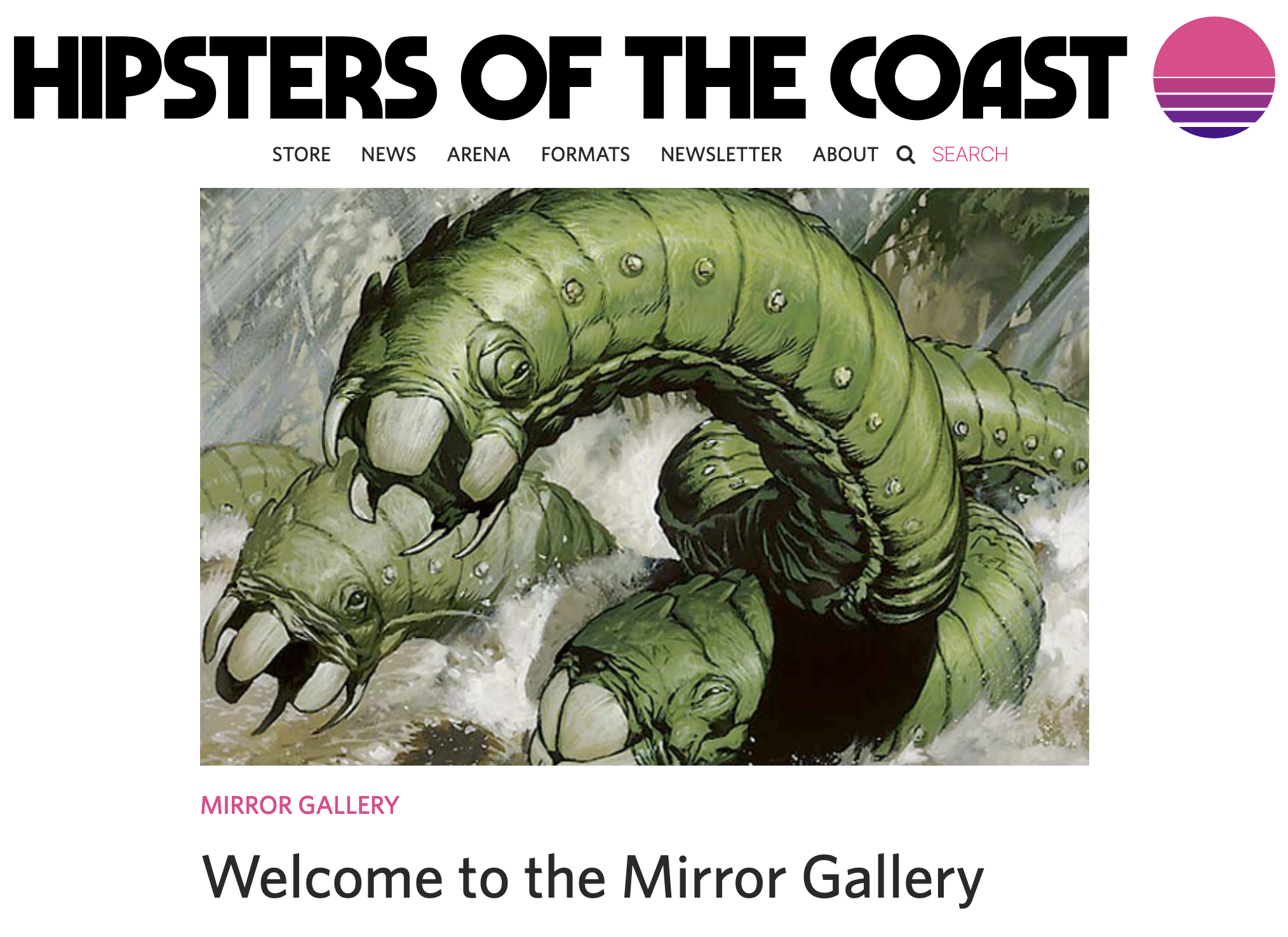
The very first Mirror Gallery.
So I started with a four article jaunt here at Hipsters, and every two weeks since a new Mirror Gallery article has hit the website. Later on that first year our fearless robot leader David McCoy suggested what would become the Art Market Minute, and then at the end of last year I took what I was doing in Magic and brought it to Marvel in Masterpiece Theater. I would have never guessed it way back when, but I spend a fair amount of my free time writing now, and it’s been an incredible journey so far. I wouldn’t change a thing, and hope in another five years I’m still writing about the artwork I love.
Andrew Mar asks: “What attracts you to MTG art?”
Magic has been a part of my life since 2003, and while the art of the game was not my primary focus until recently, I think it was always the underlying thing that kept me hooked and coming back for new sets all these years later. The very first card I ever traded for because I like the artwork was Doomsday Specter by Donato Giancola:
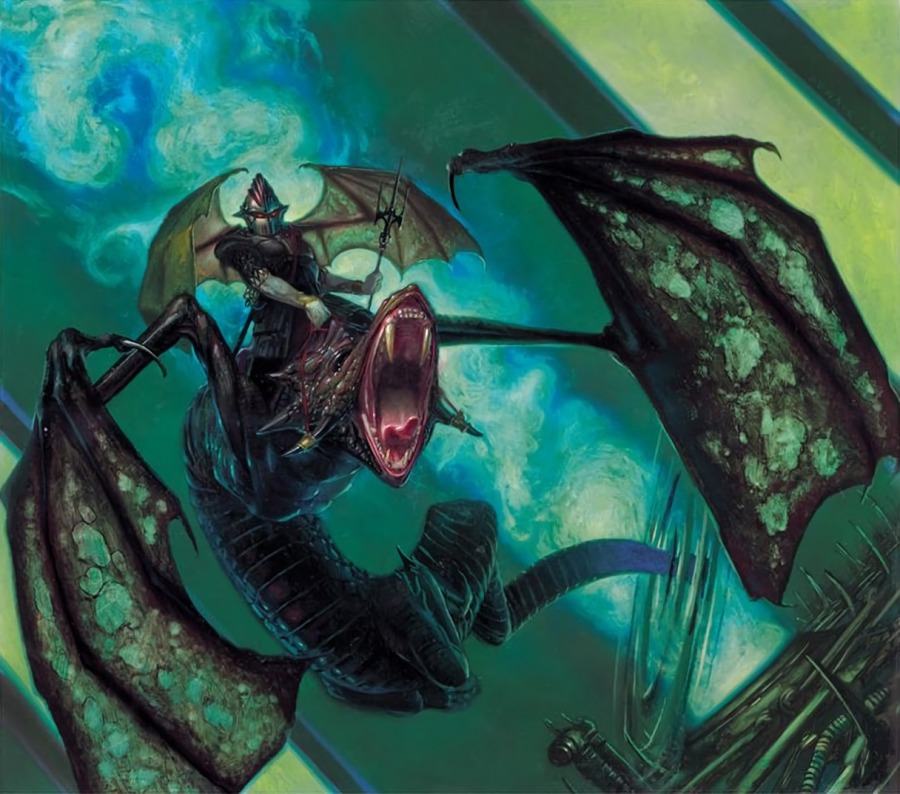
Doomsday Specter by Donato Giancola. Traditional.
The card rode my binder, always not for trade, for a decade until I finally had him sign it in 2017.
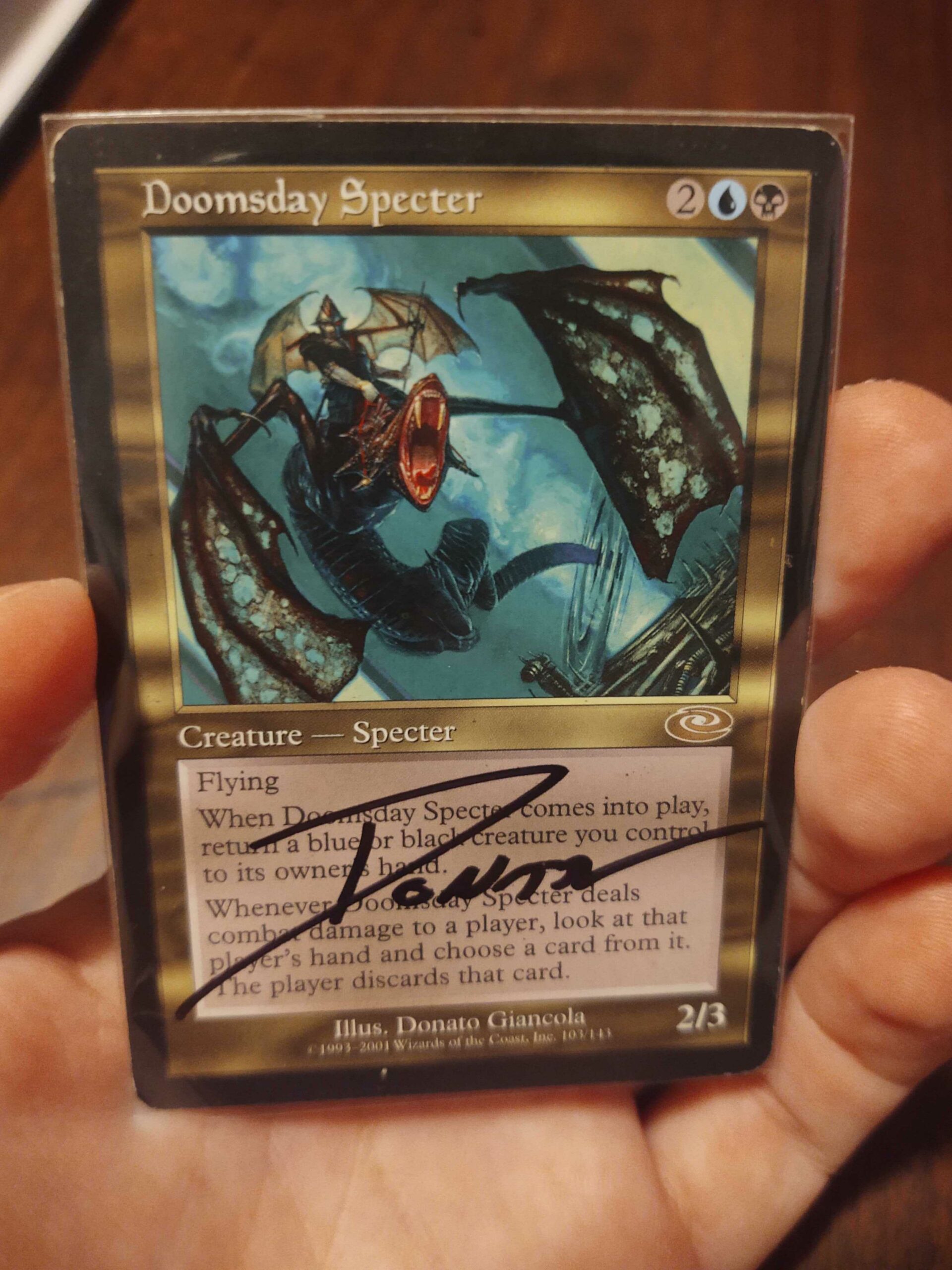
Check out those beat, well-loved corners.
But rewinding back to 2003, the narratives present in the Odyssey and Onslaught blocks, Kamahl and the Coliseum, Ixidor and the Dream Chisel, onto the metal world of Mirrodin: there was so much to see and such originality in the world building you could literally get lost within the three sets of any given block. That level of imagination is what attracted me then, and keeps me coming back now.
He also asked, “What goes on your pizza?”
I thought about this question as much as any of the other ones. It’s not so much what goes on my pizza, but where I get that particular pizza. One of my favorites is Pete’s New Haven in Washington, DC, where there exists a white pizza called the Metro-North with slow Roasted Pork, Caramelized Onions, Ricotta, and House-made Pancetta. But I also can’t forget about The Dough Roller in Ocean City, MD, where a pepperoni, sausage, and mushroom pizza is doused in parmesan and oregano until they float in the little grease cup pepperonis.

But if it’s just something chain-y like Dominos, Bacon and Extra Cheese or chicken and banana peppers sounds good to me!
VeggieWagon asks: “Which art is best?”
An impossible question, but I’d expect nothing less from my old friend VeggieWagon. I grew up playing Magic with Brett, and he’s now a Magic: the Gathering streamer and content creator with hysterical parodies and other assorted Arena-related nonsense. Check out his stuff (once you finish reading of course).
The best art in Magic is a conversation that seems to come up every so often, especially during conventions when a bunch of art nerds get around the same table. I’ll never pick just one because that doesn’t leave much room for conversation; so instead, here’s a handful of those, especially within the last ten years, that I think are the strongest artworks to have been seen in the game, and the ones always at the top of my list:
Stasis by Seb McKinnon, Mox Tantalite by Ryan Pancoast, Syncopate by Tommy Arnold, Crashing Tide by Carmen Sinek, Slippery Bogle by Jesper Ejsing, S.N.E.A.K Contraption by Ralph Horsley
Vorthos Mike asks: “What makes a good art into great?”
A story.
And while it sounds simple, when an artwork is infused with a strong narrative, or better yet allows the opportunity for one to be created by its audience, it begins to transcend its medium into something much larger. Those artworks just above here all do that. Stasis and Mox Tantalite make the viewer ask questions, not about just what’s happening, but where you are in the universe as you gaze upon them. Syncopate and Crashing Tide capture a fraction of a second frozen in time, a breath in a larger tale that we come to just as it’s happening, and are left to fill in the before and after with our past experiences.
Illuminating these stories is probably my favorite thing to do, and I’ve gotten to do it a few times in the past. My favorite was probably my article on Foxfire Oak, and for folks that might not have seen it, you can take that journey in storytelling here.
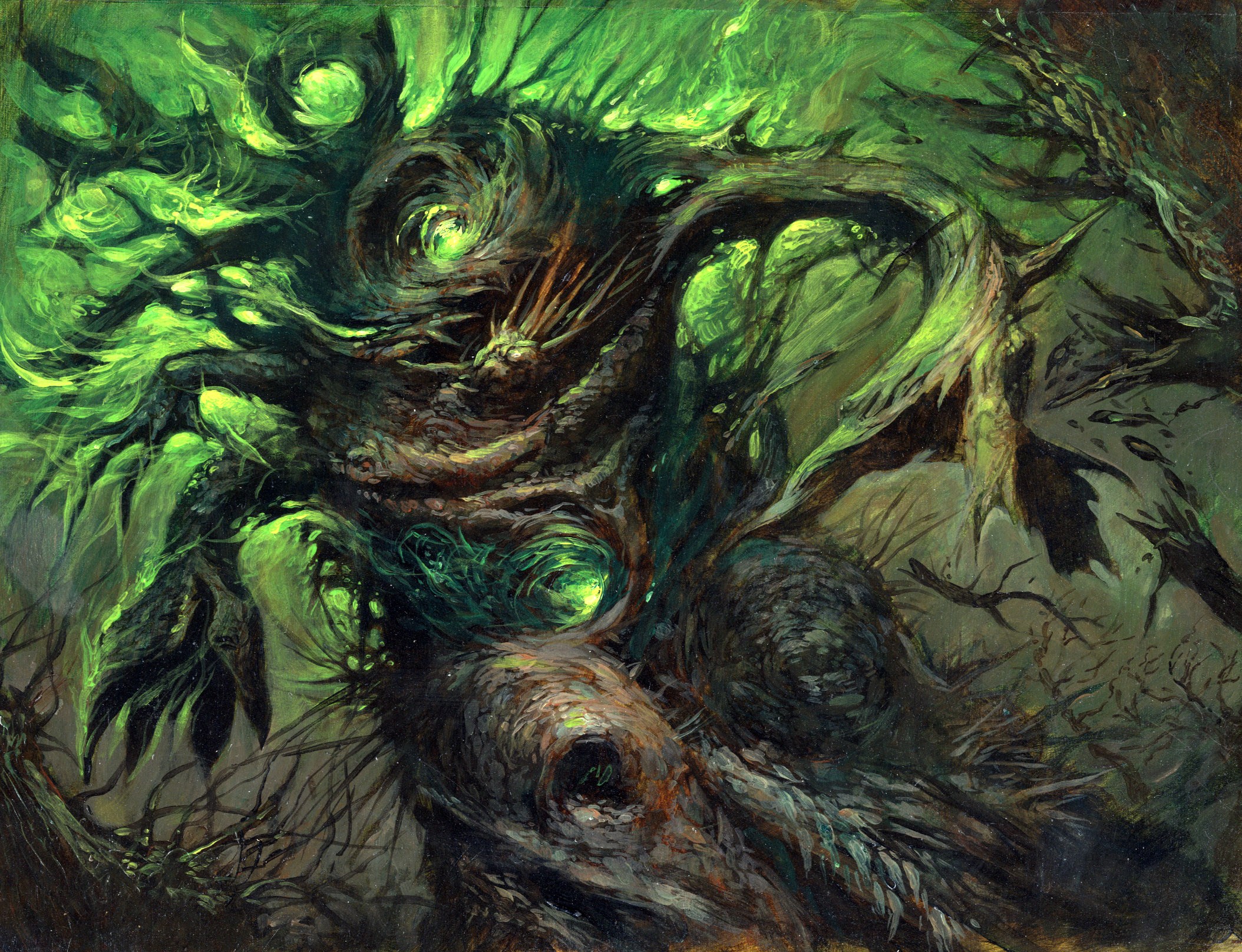
Foxfire Oak by Dave Kendall. Traditional.
Titus Lunter asks: “Is there a crossover where production art can transform into something more culturally relevant and iconic, and if so what are the drivers? Is it purely the impact on the community, voiding most artistic merits, or is it a balance?
I think we’re living in a time that the world will look back on in 100 years and view the same way we regard the Golden Age of Illustration; that’s the space that I think imaginative realism occupies, and how important it will be to the future of art.
Legends like Leyendecker, Rockwell, Mary Blair, and so many others spent most of their careers in making production art, whether for advertisements, magazine covers, animation concept art, and everything in between. In doing that, they captured the zeitgeist of when they worked, sealing within their work a mood that cannot be replicated because it’s purely of that time.
I think that seizure is the driver, being able to make something defining of its time without necessarily intending to do so. In its time, this work served a commercial purpose, but retrospectively, it’s become so much more as the essence of the time it represents.
And to your second question, I think it has to be a balance. The art I’m talking about was of considerable artistic and technical quality, and I think that’s helped it stand the test of time versus other art. There will always be that which is remembered for being “bad” but having an impact of whatever sort, but that is much of a flash in the pan versus that which will be remembered forever.
I think that the work being created today for games like Magic: the Gathering, that serves a specific, non-solely artistic purpose now, will be that same work that’s spoken of in these conversations in the future. It will change the way we look at art in the future, and be spoken of and remembered by generations to come.
We’ll end with a bit of a collecting-based cliff hanger.
John Dale Beety asks: “What’s the one that got away?’”
This one is tough, having seen the availability and price points of original Magic art pieces retreat and rise respectively over the last four years. I’ll also say I’ve been very fortunate over the last few years to be in the position to act when the right work became available, so I don’t have too many bad beat stories. But to make sure, I went onto my office laptop and found a spreadsheet that hadn’t been opened since February of 2019. It’s where I used to track pieces I had interest in, and kept it up to date before the most recent market explosion. Most everything on there is sold, but a few stand out, and perhaps none more than the original art for Dragonstorm:
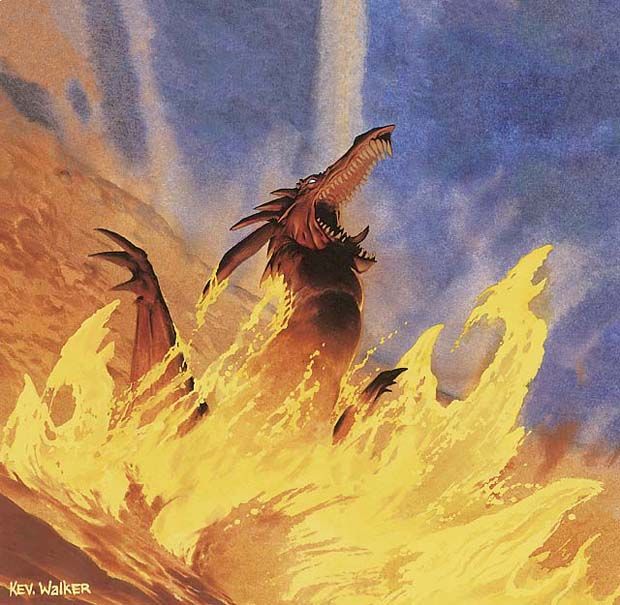
Dragonstorm by Kev Walker. Traditional.
This painting, very small as most Kev Walker pieces are, was owned by an LGS owner in the Midwest, and one late night conversation led to its availability. At the time I had just purchased two other paintings (my first two), which combined didn’t total to the asking price on Dragonstorm. I passed, not having the money at the time (nor would I have spent that much on a single artwork even if I did, if we’re being honest, this is mid-2017), but in retrospect it was an incredible deal.
Why Dragonstorm? It was the first deck I ever made a Top 8 with during a Junior Super Series run, and was perhaps the first deck I knew inside and out—every line, every matchup, perfectly tuned to my Johnny-esque love of combo Magic.
I will say looking through this sheet has reminded me of a piece that’s hiding, a gift from the artist to its current owner that still sits in its original plastic sleeve, and one that perhaps might now be available. That’s worth an email once I finish this.
It also reminded me of when I had a serious lapse in regards to Donato Giancola’s Solemn Simulacrum pencil sketch. I was first to ask when the card was first revealed, but at the time the work was intended to stay in the artist’s personal collection. It wasn’t until three days later I realized there should also be a pencil sketch (having already gotten lucky once) and asked. It already had an inquiry, and I was now second in line. By the graces that collector passed, and it now resides in my collection where I intend it to stay for the foreseeable future.
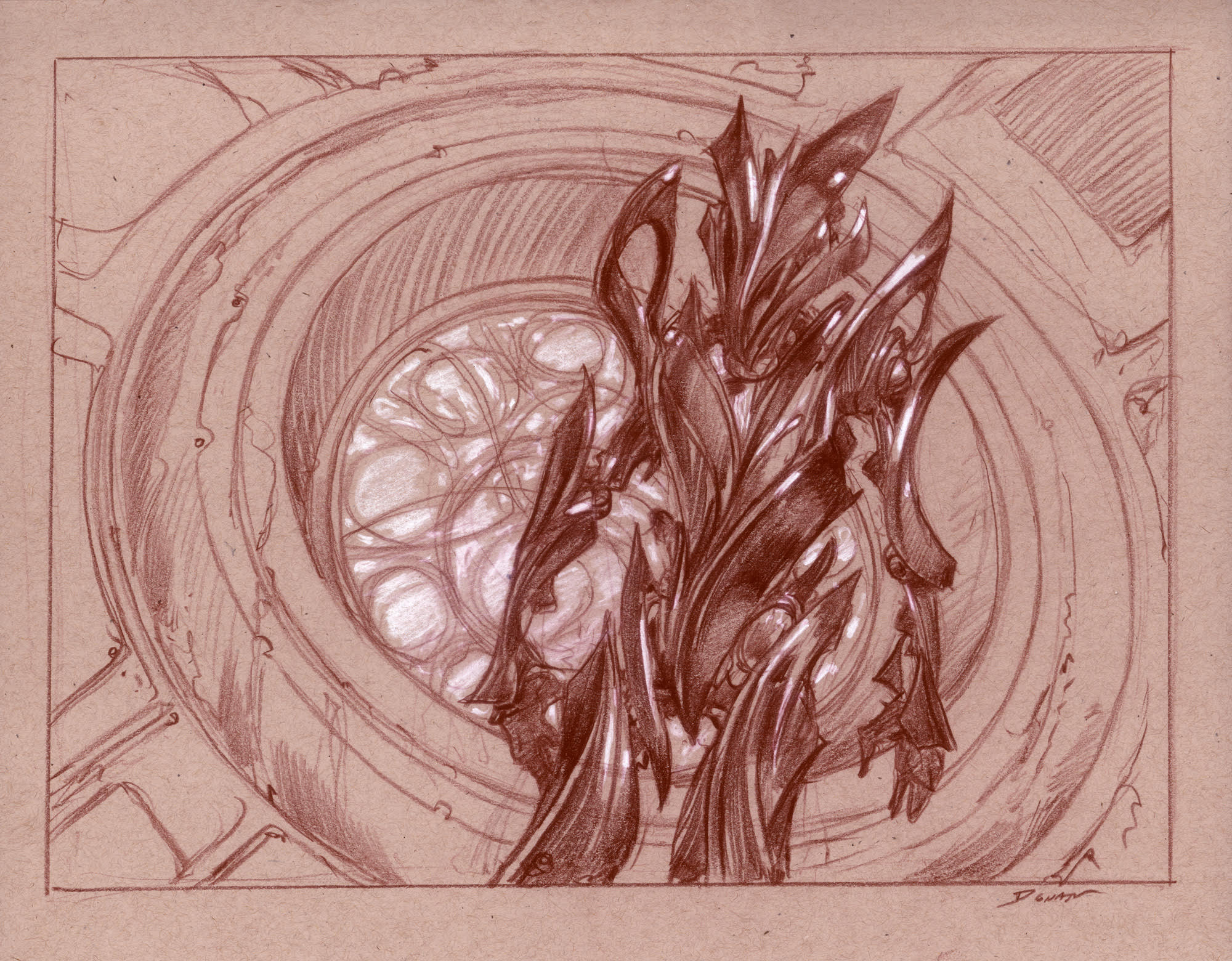
Solemn Simulacrum (Sketch) by Donato Giancola. Traditional.
I’ll end this Q&A with a piece of advice given from Pat Wilshire, founder of IX Arts and one of the most prolific collectors of contemporary imaginative realism. In short, he said that if you love a piece of art, it seems like a fair price, and can afford to do so, buy it when the opportunity arises. You can always sell it in the future, but you may not ever have the chance to buy it again. I’ve never forgotten that.
Wrapping Up
I hope you all enjoyed this peek behind the curtain of the intellectual spider-web that is the inside of my brain. I really enjoy what I do here at Hipsters, and consider it a privilege to share the stories behind the artwork of Magic: the Gathering and Marvel on a weekly basis. If this is something you enjoyed, do let me know, and I’ll plan to do another on in the future.
I think there’s still a break between any new sets or card releases for a little while longer, which has been an exciting break to let my mind wander in some other avenues I can write about. Maybe another Choosing Commander Art? Or a new installment in the Basic Land “You Pick ‘em”? I’m not entirely sure what’s coming, but I’ll be back in two weeks as I always am.
Remember, to see original #mtgart and other #vorthos related things, follow me on Twitter. Feel free to ask questions or retweet to continue the conversation. Thanks and see you next time!
Donny Caltrider has been playing Magic since 2002 and collecting original Magic art since 2017. He has an M.A. in Museum Studies from Johns Hopkins University and enjoys telling stories about art, objects, and the intersection of fantasy with real-life. You can find him on Twitter talking about #mtgart, museums, and other #vorthos related goodness. Follow along and continue the conversation!

